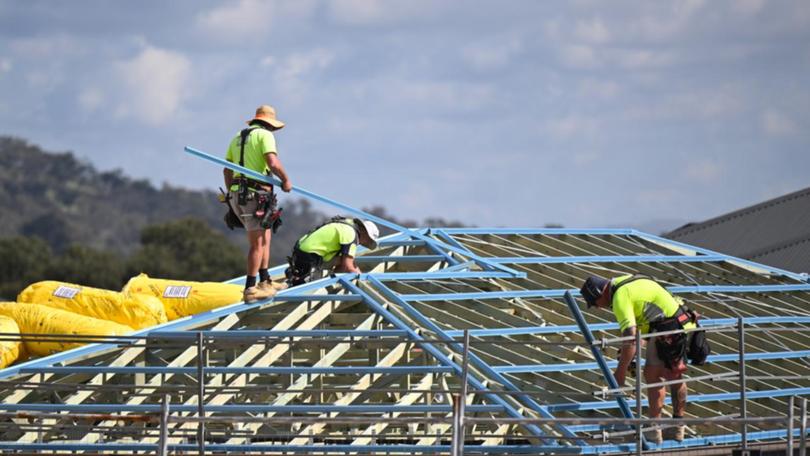JACKSON HEWETT: Short-term band-aid solutions won’t fix Australia’s housing horror show

Desperate to not scare potential homebuying voters, Labor has leapt on the Coalition’s policy banning foreign investors from buying property.
Housing Minister Clare O’Neil declared Labor wouldn’t touch the sacred cow of negative gearing – a policy that achieves little for housing affordability while requiring one taxpayer to subside the risk-taking behaviour of another to the tune of $26 billion a year.
Ms O’Neil hit the airwaves this morning trying to get in front of a Productivity Commission report that showed the country is building half as many houses per worker as it did 30 years ago.
Sign up to The Nightly's newsletters.
Get the first look at the digital newspaper, curated daily stories and breaking headlines delivered to your inbox.
By continuing you agree to our Terms and Privacy Policy.The foreign ownership policy is at least something the two parties can agree on, but it only affects a paltry 0.4 per cent of the market and is a band aid on a flesh wound.
Ms O’Neil said that decision had been made because Australians were under “real pressure”, and not just because the Coalition had already announced such a plan.
“There is no silver bullet to Australia’s housing crisis,” she told ABC radio.
“If this was an easy problem to solve, a government would have done this a long time ago.”
Her counterpart, Liberal Senator Andrew Bragg, was scathing.
“Labor adopting Coalition housing policy at the last minute will not absolve them from presiding over a housing disaster. A massive collapse in supply and nothing effective for first home buyers,” he wrote on X.
It is an idea the Coalition borrowed from Canada, a nation with a similar affordability problem, and it has failed.
Michael Brooks, chief executive of Canada’s association for property developers, REALPAC, said the policy was part of a grab bag of policies that had little impact on the market.
“The Federal Government was bending to widespread voter concern about the cost of housing They were dreaming up all kinds of initiatives, typically with poor or no research or consultation, that they said would help the market. Few actually made a difference on the supply side,” he told The Nightly.
Instead, Canada’s high immigration levels meant supply couldn’t keep up with demand.
“Cutting back on the drastic over immigration has started to bring things back into balance in Canada,” he said.
Given both parties have failed to materially address Australia’s immigration levels, the Productivity Commission report is so important. As immigration to Australia exploded over the past 30 years, the industry has had less and less ability to meet with up with demand.
The report could find no “single bullet” for the collapse in productivity, instead pointing to complex regulations, a lack of innovation and scale and workforce issues slowing down construction.
The country’s tripartite system of government led to slow-moving regulations that delayed development and increased costs. It found approval processes can stretch over a decade, with planning regulations growing increasingly dense and inconsistent across jurisdictions, leading to ‘cascading failures’. The National Construction Code, while “sound in principle” had grown to over 2000 pages, the PC found.

Innovation was mostly absent from the sector, due to a fragmented industry and the “chilling effect” of frequent regulatory changes.
Unlike most other industries, the construction sector is highly diffuse, with the average size of a construction firm just two people. Subcontractors fill the gap but small firms are inherently less efficient and able to scale.
What large firms do exist only account for 12 per cent of the market.
Lack of a skilled workforce occurred as a result of large infrastructure projects absorbing potential staff, “restrictive and inflexible training pathways” for apprentices, accreditation jurisdictions that prevented mobility and a lack of a pathway for skilled migrants.
Maxwell Shifman, chief executive of Melbourne based IntraPac property and a former president of the The Urban Development Institute of Australia said with the sector besieged by regulation from all corners, it was no surprise completion rates were so slow.
He said it was not just satisfying Federal, State and local government approvals but all the other associated bodies within those layers.
“It could be the road authorities or water and drainage authorities, power authorities. You’ve got so many different groups to satisfy that all must say yes before you can put a shovel in the ground,” he said.” if any one of them at any point starts to not do their job in a timely manner, the whole thing collapses or gets delayed.”
In an industry dominated by small players with liquidity issues, each delay eats further into profitability.
“Cash is king, and time is money when it comes to keeping a construction business afloat. Because things are taking so much longer to build compared to how they used to, you’re having to carry the overhead of the business much longer. Once you run out of cash flow, that’s why your business is insolvent,” Mr Shifman said.
Mr Shifman said the foreign investor moratorium was “fiddling around the edges” and preferred the Coalition’s $5 billion Housing Infrastructure Program, that would fund amenities like roads, power and water in greenfield developments.
Most important of all was eliminating the deadlock of legislation and Mr Shifman said he would be the “first to put his hat into the ring” to lead a DOGE-style razor through red tape.
“Running a national business, I get the absolute pleasure of dealing with a myriad of different planning authorities and bureaucracies around the nation. There are very few that I can point to as being wonderful at their job or fast enough,” he said.
“If there was a national housing tsar that could say, ‘I hear you, but this is what we’re going to do’ and just get on with the job, that would make a big difference.”
Mr Shifman called out the perverse impacts of government policies around foreign ownership, pointing to the high-rise developments that grown up around Melbourne and Sydney catering to foreign students.
As part of a plan to reduce foreign buyers, extra stamp duty and other restrictions were applied, meaning inner city apartment blocks were no longer built.
“What all those changes did was actually reduce a very, very substantial supply of new rental properties into the marketplace, that would have had relatively affordable rents. I’m not here to debate the aesthetics of towers in the city, but certainly it met the market for those international students.”
Those students, of course, kept coming, propping up another sector of the economy and competing for housing with the hundreds of thousands of permanent migrants, and the natural increase in Australian citizens graduating out of family homes.
Both parties have overseen large levels of migration, hooked on the GDP bump from new arrivals. And neither party has solved the housing affordability problem despite 30 years of warnings.
Perhaps it is time to stop “fiddling around the edges.”

